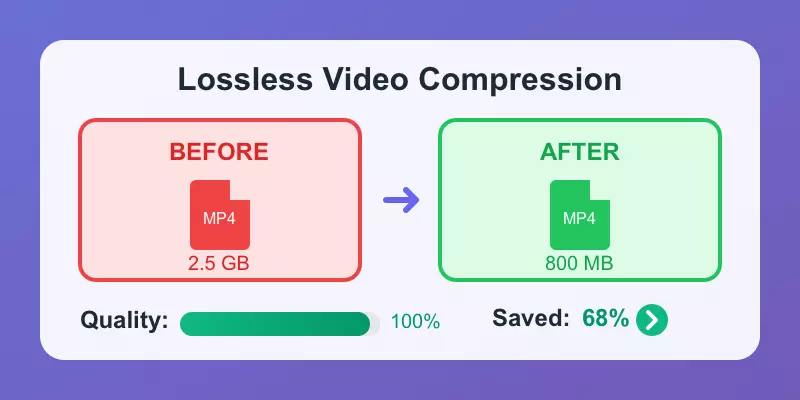Table of Contents
Advanced video conversion goes beyond basic format changes. It involves understanding complex encoding parameters, leveraging hardware acceleration, and implementing professional workflows that deliver superior quality while optimizing processing time and file sizes.
This comprehensive guide will take you through professional-grade video conversion techniques used by industry experts, content creators, and video professionals worldwide.
Understanding Advanced Codecs
Modern video codecs offer sophisticated compression algorithms that can dramatically improve quality and efficiency when properly configured.
H.265/HEVC
Next-GenAdvantages: 50% better compression than H.264, 4K/8K support
Best for: High-resolution content, streaming, archival
Settings: CRF 18-23, Medium/Slow preset
AV1
Open SourceAdvantages: Royalty-free, excellent compression
Best for: Web streaming, future-proofing
Settings: CQ 25-35, CPU-used 4-6
VP9
GoogleAdvantages: Good compression, web-friendly
Best for: YouTube, web platforms
Settings: CRF 15-35, Good/Best quality
Codec Selection Strategy
- H.264: Maximum compatibility, older devices
- H.265: Modern devices, 4K content, storage efficiency
- AV1: Future-proofing, web streaming
- ProRes/DNxHD: Professional editing workflows
Hardware Acceleration Techniques
Hardware acceleration can reduce conversion times by 5-10x while maintaining quality. Understanding when and how to use it is crucial for professional workflows.
NVIDIA NVENC
Best for: Real-time encoding, streaming, batch processing
Advantages:
- Extremely fast encoding
- Low CPU usage
- Good quality with proper settings
- Supports H.264, H.265, AV1
Considerations:
- Requires NVIDIA GPU
- Quality slightly lower than CPU
- Limited advanced settings
AMD VCE/VCN
Best for: AMD systems, budget-conscious workflows
Advantages:
- Fast encoding speeds
- Good power efficiency
- Improving quality
- Wide GPU support
Considerations:
- Quality behind NVENC
- Fewer software options
- Limited codec support
Intel Quick Sync
Best for: Intel systems, mobile devices, low power
Advantages:
- Very low power consumption
- Built into most Intel CPUs
- Good for mobile/laptop
- Decent speed
Considerations:
- Lower quality output
- Limited advanced features
- Inconsistent performance
Advanced Encoding Settings
Professional video conversion requires understanding and optimizing numerous encoding parameters:
Rate Control Methods
Constant Rate Factor (CRF)
Best for: Archival, high-quality output
Settings: H.264: 18-23, H.265: 20-28
Maintains consistent quality across the entire video
Variable Bitrate (VBR)
Best for: Streaming, size-constrained scenarios
Settings: Target bitrate with min/max bounds
Balances quality and file size effectively
Constant Bitrate (CBR)
Best for: Live streaming, broadcast
Settings: Fixed bitrate throughout
Predictable bandwidth usage
Advanced Parameters
Preset Selection
- Ultrafast: Real-time applications
- Fast: Live streaming, quick turnaround
- Medium: Balanced speed/quality
- Slow/Slower: High-quality archival
- Veryslow: Maximum quality
Profile and Level
H.264: High Profile, Level 4.1+ for HD
H.265: Main10 Profile for 10-bit content
Ensures compatibility with target devices
Batch Processing and Automation
Efficient batch processing is essential for professional workflows dealing with large volumes of content.
Organize Source Material
- Create consistent folder structures
- Use descriptive naming conventions
- Separate content by resolution/format
- Maintain backup copies
Create Processing Profiles
- Web streaming profile (H.264, 1080p)
- Mobile profile (H.264, 720p, lower bitrate)
- Archive profile (H.265, original resolution)
- Social media profiles (platform-specific)
Implement Quality Control
- Automated quality checks
- File integrity verification
- Metadata preservation
- Error logging and reporting
Monitor and Optimize
- Track processing times
- Monitor system resources
- Adjust queue priorities
- Schedule processing during off-hours
Automation Tools
- FFmpeg scripts: Command-line automation
- Watch folders: Automatic processing triggers
- Cloud processing: Scalable batch operations
- Workflow management: Complex multi-step processes
Quality Optimization Strategies
Achieving optimal quality requires understanding the relationship between various encoding parameters and their impact on visual fidelity.
Visual Quality
- Use appropriate CRF values for content type
- Enable adaptive quantization
- Optimize for target viewing conditions
- Consider perceptual quality metrics
Compression Efficiency
- Use two-pass encoding for critical content
- Enable advanced features (CABAC, 8x8 DCT)
- Optimize reference frame settings
- Fine-tune motion estimation
Size vs Quality
- Use VMAF for objective quality assessment
- Test multiple encoding settings
- Consider target bandwidth constraints
- Optimize for specific content types
Device Compatibility
- Test on target devices
- Use appropriate profiles and levels
- Consider hardware decoder limitations
- Provide multiple quality options
Professional Workflows
Industry-standard workflows ensure consistent, high-quality results while maximizing efficiency.
Broadcast Workflow
Requirements: Strict quality standards, specific formats
- Use broadcast-safe color levels
- Maintain audio sync precision
- Include closed captions and metadata
- Follow delivery specifications exactly
Streaming Workflow
Requirements: Multiple bitrates, adaptive streaming
- Create ABR ladder (multiple qualities)
- Optimize for different devices
- Include thumbnail generation
- Implement DRM if required
Archive Workflow
Requirements: Long-term preservation, maximum quality
- Use lossless or near-lossless encoding
- Preserve all metadata
- Create multiple format copies
- Implement checksum verification
Social Media Workflow
Requirements: Platform-specific optimization
- Follow platform guidelines
- Optimize for mobile viewing
- Include platform-specific metadata
- Create multiple aspect ratios
Troubleshooting Common Issues
Encoding Artifacts
Symptoms: Blocking, banding, mosquito noise
Solutions: Increase bitrate, use slower preset, enable deblocking filter
Audio Sync Issues
Symptoms: Audio drift, lip sync problems
Solutions: Check frame rate consistency, use audio resampling, verify timecode
Compatibility Problems
Symptoms: Won't play on certain devices
Solutions: Use compatible profiles/levels, check codec support, test on target devices
Performance Issues
Symptoms: Slow encoding, system freezes
Solutions: Optimize thread usage, enable hardware acceleration, monitor system resources
Conclusion
Advanced video conversion techniques require a deep understanding of codecs, encoding parameters, and workflow optimization. The key to success lies in:
- Choosing the right codec for your specific use case
- Leveraging hardware acceleration when appropriate
- Optimizing encoding settings for quality and efficiency
- Implementing robust batch processing workflows
- Continuously testing and refining your processes
Remember that video conversion is both an art and a science. While technical knowledge is crucial, understanding your audience and their viewing conditions is equally important for delivering the best possible experience.
Ready for Professional Video Conversion?
SioVue Video Converter Pro offers advanced features including hardware acceleration, batch processing, and professional-grade encoding options.
Try SioVue Video Converter Pro



